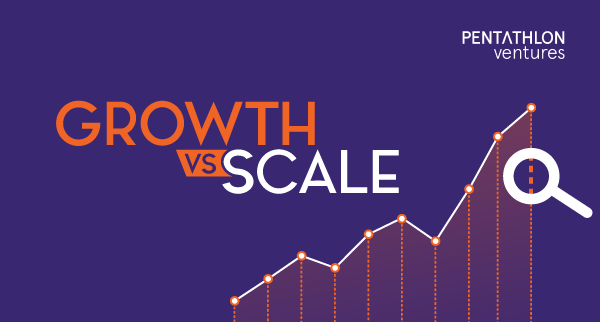“Scaling and growing, aren’t they the same thing?”
It’s unfortunate that the two terms are used interchangeably so often. Founders who look at these metrics separately stand to gain much insight. To understand whether an organization is growing or scaling is to understand whether it’s adjusting to today’s growth or preparing for tomorrow’s growth.
What’s the difference?
‘Are you growing?’ asks a simple question. It’s a question of whether you’re doing more business today than you did yesterday. That means more customers, more resources being deployed, or more feet on the ground selling in more geographies.
‘Are you scaling?’ asks a very different question. It’s a question of whether you’re growing more efficiently today than you were yesterday. It asks if unit economics are improving over time, how fast are you increasing your ability to do more with less. That means more recurring revenue, greater velocity of inbound leads, or greater revenue efficiency.
Once the distinction is made, it’s suddenly easy to spot companies that are growing but not scaling.
What does it look like to grow but not scale?
It looks like a decrease in profit margins or customer satisfaction as the company grows. It looks like a demotivated team or failed international expansions. Rapid growth is exciting, but uncontrollable growth that’s inefficient and unsustainable is not. Growth without scalability means you’ll be plugging leaks and putting out fires constantly or expending a lot of resources to sustain growth. Every founder knows how that feels.
Of course, sometimes you have to grow and see what’s falling apart before fixing it and improving scalability. Trial and error are part of the game. Growth is important, because it decides the valuation. But scalability makes growth less painful and less risky.
Starting on the path to scalability
The very first thing to do is to start talking about both, scalability and growth. Many founders look closely at their growth but not their scalability. Asking the right question immediately improves the chances of finding the right answer.
The second thing to do is to look at culture, and whether it’s built for scalability. Are employees empowered and enabled to take the right decisions autonomously? Are core values sitting in a vision document or actually making their way into the company culture?
The third and most important thing to do, is to fire yourself. Just from the little things, so you can focus on the big things. Replace yourself, and more often than not you’ll find your replacement does the job just as good or better than you. Then repeat the same for your high value team members. Fire them from the tasks that eat up their time so they can get to work on the bigger problems.
It won’t be an easy effort, but it can be rewarding to find out whether you have the DNA of scale or if you still need to build it.




